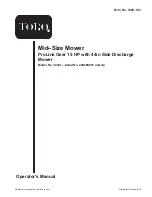
Lawn Care
& Mowing Information
TYPES OF GRASS, CLIMATE AND
CONDITIONS
A variety of grasses are commonly grown in household
lawns, but two main groups known as cool-season
grasses (varieties of bluegrass, ryegrass, and fescue),
and warm-season grasses (typically bermuda, buffalo-
grass, and zoysia varieties) are the most common.
The cool-season grasses are better suited to cooler cli-
mates, and do not endure hot and dry weather as well as
warm-season grasses, but conversely, the warm-season
grasses do not grow as well in cooler climates. Most resi-
dential lawns are typically seeded with a mixture of these
grasses. (A local nursery or lawn center may help you to
identify what kind of grass your lawn contains from a
sample.)
Knowing your climate and conditions is also important to
proper lawn care. Drier climates or conditions will require
additional watering, while wetter climates may require
more frequent mowing.
HOW AND WHEN TO WATER,
FERTILIZE & AERATE
Every lawn’s watering needs are unique and are depen-
dent upon the type of grass and soil, the amount of local
rainfall, and other conditions. Most lawns are watered
too often, but with too little water. However too much
water can allow development of diseases with your lawn.
It is best to water the lawn only when necessary, and
then to water it slowly, evenly, and deeply—imitating
a slow, soaking rain.
WHEN TO WATER YOUR LAWN
When the lawn begins to wilt, the grass’s color dulls, or
footprints stay compressed for more than a few seconds,
the lawn is beginning to dry out, and needs additional
moisture. The best time to water is early morning to allow
the water to soak deeply into the lawn and reduce the
amount that evaporates in the hot afternoon sun.
LC—1
HOW TO WATER YOUR LAWN
The best method of watering a lawn is to imitate a slow,
soaking rain, applying about 1 inch of water. A method
of verifying the amount that you have watered, is to place
several empty tin cans (low shallow cans work best) in
various spots around the lawn, and check the depth of
water in the can during the watering process.
HOW TO FERTILIZE YOUR LAWN
Fertilizing with a slow-release fertilizer provides missing
nutrients which help create slow, even growth. While
opinions vary on the need for fertilizing, when and how
much to fertilize will be more a factor of the condition of
the lawn and soil than any routine. Remember that over-
fertilizing can cause harm, and that most fertilizing
should be applied in the spring so that it will release into
the lawn through the summer. For more information,
check with a local nursery or lawn care specialist, and
read and follow the fertilizer manufacturer’s instructions.
AERATING YOUR LAWN
Consider aerating your lawn in spring. Using an aerator
to remove cores of soil from the lawn increases the
speed of clipping decomposition and encourages deeper
root growth by opening up the soil and permitting greater
movement of water, fertilizer and air.
GENERAL INFORMATION
Proper mowing is an important part of maintaining your
lawn in the best possible condition. A healthy and well
maintained lawn is better able to resist drought, weeds,
and other stresses. But too much maintenance is as
detrimental to your lawn as neglect. Proper care for your
lawn involves more than just “cutting the grass.” To have
a healthy lawn, you need to know:
✘
Types of Grass, Climate and Conditions
✘
How and When to Water, Fertilize & Aerate
✘
How High to Mow the Grass
✘
When and How Often to Mow
✘
What Mowing Patterns to Use
✘
Proper Mowing Methods
✘
How to Solve Common Mowing Problems
TP 600-2136-01-UV-SMA








































